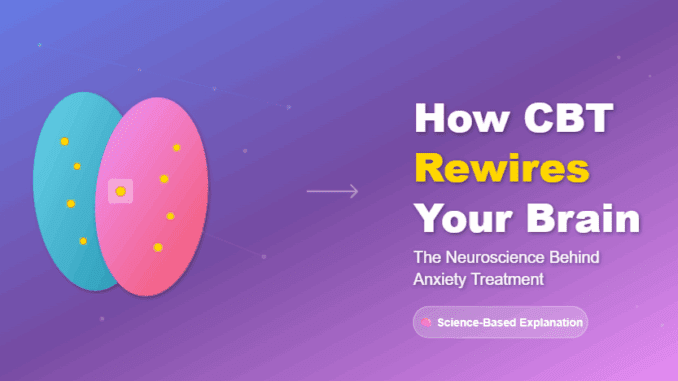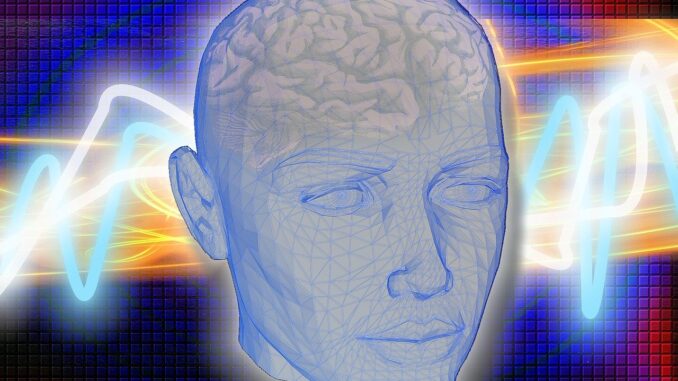
CBT Rewires The Brain
If you’ve ever wondered whether therapy can actually change your brain—not just your thoughts—the answer is a resounding yes. As a cognitive behavioral therapist practicing in Chicago’s Lakeview neighborhood, I’ve witnessed countless clients experience profound transformations through CBT. But what’s happening beneath the surface? Recent neuroscience research reveals that cognitive behavioral therapy literally rewires the neural pathways in your brain.
Let’s explore the fascinating science behind how CBT changes your anxious brain and why these changes lead to lasting relief.
What Happens in an Anxious Brain?
Before we dive into how CBT creates change, it’s important to understand what’s happening in your brain when you experience anxiety.
When you feel anxious, your brain’s threat detection system—primarily the amygdala—goes into overdrive. This almond-shaped structure acts like an alarm system, constantly scanning for danger. In people with anxiety disorders, this alarm is hypersensitive, triggering fight-or-flight responses even when there’s no real threat.
Meanwhile, your prefrontal cortex—the brain’s rational control center—struggles to regulate these emotional responses. It’s like having a smoke detector that goes off every time you make toast, while the person who should be turning it off is too overwhelmed to act.
This imbalance between the emotional (amygdala) and rational (prefrontal cortex) parts of your brain creates the physical symptoms you experience: racing heart, sweating, difficulty concentrating, and that overwhelming sense of dread.
The Science of Neuroplasticity: Your Brain Can Change
Here’s the good news: your brain possesses an incredible ability called neuroplasticity—the capacity to form new neural connections and reorganize existing ones throughout your lifetime. Think of it like your brain’s software being constantly rewritable, not hardwired.
Every time you think a thought or perform a behavior, you strengthen certain neural pathways. Repeat that thought or behavior enough times, and those pathways become highways—your brain’s default routes. This is why anxiety can feel so automatic and overwhelming. Your brain has learned to take the “anxiety highway” without even thinking about it.
But here’s where CBT becomes powerful: if you can strengthen anxious pathways through repetition, you can also build new, healthier pathways using the same principle.

10 Ways CBT Rewires Your Brain
1. Reduces Amygdala Hyperactivity
Research using brain imaging shows that CBT decreases both the volume and sensitivity of the amygdala in people with anxiety disorders. After completing CBT treatment, brain scans reveal that the amygdala becomes less reactive to perceived threats. Where your brain once immediately jumped to panic, it now pauses and evaluates more accurately.
Working with clients experiencing social anxiety, I often see this transformation. Someone who once felt their heart race at the thought of speaking in a meeting gradually notices that their body doesn’t respond as intensely. Their brain has literally learned a new response.
2. Strengthens Prefrontal Cortex Function
CBT exercises boost activity in your prefrontal cortex—particularly the areas responsible for executive function, decision-making, and emotional regulation. This is the part of your brain that can logically evaluate situations and calm down the amygdala’s alarm bells.
Studies show that after CBT, the prefrontal cortex becomes more active and better at its job of regulating emotions. It’s like upgrading from a whisper to a strong, clear voice that can effectively communicate with your emotional brain.
3. Improves Neural Efficiency
One of the most fascinating findings in recent research is that CBT doesn’t just change which brain areas are active—it makes your brain work more efficiently. Initially, your brain might be working overtime to manage anxiety, burning through mental energy. After CBT, brain scans show decreased activation in certain areas, but with better outcomes.
This isn’t because your brain is doing less; it’s because it’s working smarter. Like learning to ride a bike, what once required intense concentration becomes smooth and automatic.
4. Enhances Connectivity Between Brain Regions
Anxiety often results from poor communication between different brain regions. CBT improves the functional connectivity between your prefrontal cortex and limbic system (the emotional center of your brain). This creates better “top-down” regulation—your thinking brain can more effectively manage your emotional brain.
Research has identified specific networks that improve with CBT:
- The default mode network (involved in self-referential thinking)
- The executive control network (responsible for cognitive control)
- The salience network (which determines what deserves your attention)
5. Reduces Rumination Patterns
When clients first come to my practice in Lakeview, many describe being trapped in cycles of negative thinking—rumination that seems impossible to escape. Brain imaging studies show that CBT decreases activity in the precuneus, a brain region associated with rumination and self-focused worry.
Through techniques like changing negative thinking patterns, you’re not just thinking different thoughts—you’re actually changing the neural patterns that generate those thoughts in the first place.
6. Strengthens the Anterior Cingulate Cortex
The anterior cingulate cortex (ACC) acts like a conflict monitor in your brain, helping you detect when something needs attention and assisting in error correction. CBT strengthens this region, improving your ability to notice when anxious thoughts arise and choose different responses.
This is why many of my clients report that while anxious thoughts still occasionally appear, they feel more able to observe them without getting swept away. Their ACC has become stronger at catching these thoughts early.
7. Modifies Threat Processing
CBT literally changes how your brain processes potential threats. Before treatment, someone with anxiety might see a neutral face as threatening or interpret ambiguous situations as dangerous. After CBT, brain scans show altered activation patterns when viewing emotional faces or processing potentially threatening information.
Your brain learns to distinguish between actual danger and false alarms—a crucial skill for anyone struggling with panic attacks or generalized anxiety.
8. Creates New Memory Associations
Part of what makes anxiety so persistent is that your brain has learned to associate certain situations with danger. If you’ve had a panic attack on the CTA in Chicago, your brain might start to associate all public transportation with threat.
Through exposure exercises in CBT, you create new memory associations. Your hippocampus—the brain’s memory center—begins storing new experiences that compete with the old fearful memories. Over time, these new memories can become stronger than the old ones.
9. Increases Gray Matter Volume
Some studies have found that CBT can actually increase gray matter volume in specific brain regions associated with emotional regulation and cognitive control. While you can’t dramatically bulk up your brain like a muscle, sustained practice of CBT skills appears to promote structural changes at the cellular level.
10. Promotes Long-Term Neural Changes
Perhaps most importantly, the brain changes created by CBT appear to be long-lasting. Unlike some interventions that provide temporary relief, CBT creates enduring modifications to neural circuitry. This is why many people who complete CBT continue to experience reduced anxiety symptoms long after therapy ends.
The skills you learn become hardwired through practice, creating new default pathways that your brain naturally follows.

How Long Does It Take for CBT to Rewire Your Brain?
One of the most common questions I hear from clients at our Chicago practice is: “How long will this take?”
Research shows that meaningful brain changes can begin to appear within just 8-12 weeks of consistent CBT work. Brain scans taken after just two months of therapy have revealed measurable differences in neural activation patterns.
However, like any skill, the more you practice, the stronger the neural pathways become. Most evidence-based CBT protocols run 12-20 sessions, giving your brain sufficient time to establish new patterns and make them automatic.
What CBT Techniques Create These Brain Changes?
The brain changes we’ve discussed don’t happen by magic—they result from specific CBT techniques practiced consistently:
- Cognitive Restructuring: Identifying and challenging distorted thoughts activates your prefrontal cortex and teaches it to override the amygdala’s alarm signals.
- Exposure Therapy: Gradually facing feared situations creates new, non-threatening memory associations and reduces amygdala reactivity.
- Behavioral Experiments: Testing your anxious predictions against reality strengthens neural pathways associated with accurate threat assessment.
- Mindfulness and Present-Moment Awareness: These practices, which we often incorporate through Acceptance and Commitment Therapy (ACT), enhance connectivity between brain regions and reduce rumination.
- Problem-Solving Skills: Learning structured approaches to challenges strengthens executive function networks in your prefrontal cortex.
The Chicago Connection: Why Location Matters for Your Brain
While brain science is universal, I’ve found that incorporating local context makes CBT more effective. When we work on health anxiety by doing exposure exercises near Northwestern Memorial Hospital, or address social anxiety by gradually attending events in Lincoln Park, we’re creating locally-relevant neural pathways.
Your brain doesn’t learn in a vacuum—it learns in the context of your daily life. That’s why working with a therapist who understands Chicago-specific triggers (like navigating crowded L trains during rush hour or managing work stress in the Loop) can create more meaningful and lasting brain changes.
CBT vs. Medication: Different Pathways to Brain Change
You might wonder how CBT’s effects on the brain compare to anti-anxiety medication. Both can create beneficial brain changes, but they work through different mechanisms.
Medications typically alter neurotransmitter levels (like serotonin or GABA) throughout your brain, providing relief relatively quickly but requiring ongoing use to maintain benefits. CBT, on the other hand, creates structural and functional changes to specific neural circuits through learning and practice.
Interestingly, some research suggests that successful CBT and effective medication can produce similar patterns of brain change, particularly in the prefrontal cortex and amygdala. However, CBT’s effects often persist longer after treatment ends because you’ve learned skills and created new neural pathways that remain even without ongoing intervention.
For many people, a combination approach works best, especially when anxiety is severe. Medication can reduce symptoms enough to engage fully in CBT, while therapy creates the lasting brain changes that may eventually make medication unnecessary.
What This Means for Your Anxiety Treatment
Understanding that CBT rewires your brain has several important implications:
- Change Is Physical, Not Just Mental: When you feel like CBT is “working,” you’re not imagining it—your brain is literally changing its structure and function.
- Practice Matters: Just like you can’t build muscle by thinking about exercise, you can’t rewire your brain without actually practicing CBT skills. The homework between sessions isn’t busywork—it’s the mechanism through which neural change occurs.
- Be Patient: Brain rewiring takes time. If you don’t feel dramatically different after a few sessions, that doesn’t mean it’s not working. Meaningful neural changes are occurring beneath your awareness.
- Skills Become Automatic: Initially, using CBT techniques might feel effortful and unnatural. With practice, as new neural pathways strengthen, these skills become your brain’s new defaults—automatic and effortless.
- Change Can Last: Because CBT creates structural brain changes, the improvements you experience aren’t just temporary mood boosts—they’re based on fundamental shifts in how your brain processes information.
Taking the Next Step
If you’re struggling with anxiety in Chicago, understanding that your brain can change should be empowering. You’re not stuck with the neural patterns you have today. Through CBT, you can literally rewire the circuits that generate anxiety, creating lasting change at the most fundamental level.
At our practice near Lakeview and Roscoe Village, we use evidence-based CBT techniques specifically designed to create these beneficial brain changes. Whether you’re dealing with social anxiety, panic attacks, generalized anxiety, or OCD, CBT offers a scientifically-validated path to a calmer, more balanced brain.
Your brain has spent years learning to be anxious. The good news? It can learn something new. And that learning begins with taking the first step.
